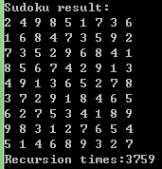本文为大家分享了java多线程的简单实现及线程池实例,供大家参考,具体内容如下
一、多线程的两种实现方式
1、继承Thread类的多线程
|
1
2
3
4
5
6
7
8
9
10
11
12
13
14
15
16
17
18
19
20
21
|
/** * 继承Thread类的多线程简单实现 */public class extThread extends Thread { public void run(){ for(int i=0;i<100;i++){ System.out.println(getName()+"-"+i); } } public static void main(String arg[]){ for(int i=0;i<100;i++){ System.out.println(Thread.currentThread().getName()+"-"+i); if(i==50){ new extThread().start(); new extThread().start(); } } } } |
2、实现Runnable接口的多线程
|
1
2
3
4
5
6
7
8
9
10
11
12
13
14
15
16
17
18
19
20
21
22
|
/** * 实现runable接口的多线程实例 */public class runThread implements Runnable { public void run(){ for(int i=0;i<100;i++){ System.out.println(Thread.currentThread().getName()+"-"+i); } } public static void main(String arg[]){ for(int i=0;i<100;i++){ System.out.println(Thread.currentThread().getName()+"-"+i); if(i==50){ runThread rt = new runThread(); new Thread(rt,"新线程1").start(); new Thread(rt,"新线程2").start(); } } } } |
二、线程池的简单实现
|
1
2
3
4
5
6
7
8
9
10
11
12
13
14
15
16
17
18
19
20
21
22
23
24
|
//实现Runnable接口 class TestThread implements Runnable{ public void run() { for(int i = 0;i < 100;i++){ System.out.println(Thread.currentThread().getName() + "i的值为:" + i); } } } public class threadPoolTest { public static void main(String[] args) { //创建一个具有固定线程数的线程池 ExecutorService pool = Executors.newFixedThreadPool(5); //向线程池中提交三个线程 pool.submit(new TestThread()); pool.submit(new TestThread()); pool.submit(new TestThread()); //关闭线程池 pool.shutdown(); } } |
三、java爬虫使用线程池实例
|
1
2
3
4
5
6
7
8
9
10
11
12
13
14
15
16
17
18
19
20
21
22
23
24
25
26
27
28
29
30
31
32
33
34
35
36
37
38
39
40
41
42
43
44
45
46
47
48
49
50
51
52
53
54
55
56
57
58
59
60
61
62
63
64
65
66
67
68
69
70
71
|
/** * 爬虫调度线程池 */public class threadPool { public static HashMap<String, Spiders> statusMap = new HashMap<String, Spiders>(); // 存放爬虫,key为爬虫的id,value为爬虫的线程池 static HashMap<Integer, ThreadPoolExecutor> threadMap = new HashMap<Integer, ThreadPoolExecutor>(); //创建一个线程池 static ThreadPoolExecutor threadPool = new ThreadPoolExecutor(200, 230,80000L, TimeUnit.SECONDS, new ArrayBlockingQueue<Runnable>(10), new ThreadPoolExecutor.CallerRunsPolicy()); public static void executeThread(Spiders spider) { statusMap.put(String.valueOf(spider.getId()), spider); // 爬虫有效 if (spider.getFlag() == 0) { if (spider.getStatus() == 0) { // 表示爬虫进入抓取状态 ThreadPoolExecutor detailPool = null; if (threadMap.get(spider.getId()) == null) { detailPool = new ThreadPoolExecutor(30, 80, 80000L, TimeUnit.SECONDS, new ArrayBlockingQueue<Runnable>( 10), new ThreadPoolExecutor.CallerRunsPolicy()); threadMap.put(spider.getId(), detailPool); threadPool.execute(new threadRun(spider, threadMap)); } } } } } //实现Runnable接口 class threadRun implements Runnable { private HashMap<Integer, ThreadPoolExecutor> threadPoolMap; private Spiders spider; public threadRun(Spiders spider, HashMap<Integer, ThreadPoolExecutor> threadPoolMap) { this.threadPoolMap = threadPoolMap; this.spider = spider; } //线程执行体 public void run() { try { if ("rong360".equals(spider.getWebsite())) { new RongThread(threadPoolMap.get(spider.getId()), spider) .startSpider(); } else if ("xxgg_sd".equals(spider.getWebsite())) { new Spider_ShanDong(threadPoolMap.get(spider .getId()), spider).startSpider(); } else if ("xxgg_gz".equals(spider.getWebsite())) { new Spider_GuiZhou(threadPoolMap.get(spider .getId()), spider).startSpider(); } else if ("sx".equals(spider.getWebsite())) { new SpiderSX(spider).startSpider(); } else if ("baidu".equals(spider.getWebsite())) { new SpiderBaiDu(spider).startSpider(); } else if ("11315".equals(spider.getWebsite())) { new Spider11315ByName(spider).startSpider(); } } catch (Exception e) { e.printStackTrace(); } } } |
以上就是本文的全部内容,希望对大家的学习有所帮助,也希望大家多多支持服务器之家。
原文链接:https://blog.csdn.net/William_hangshao/article/details/67644335

















